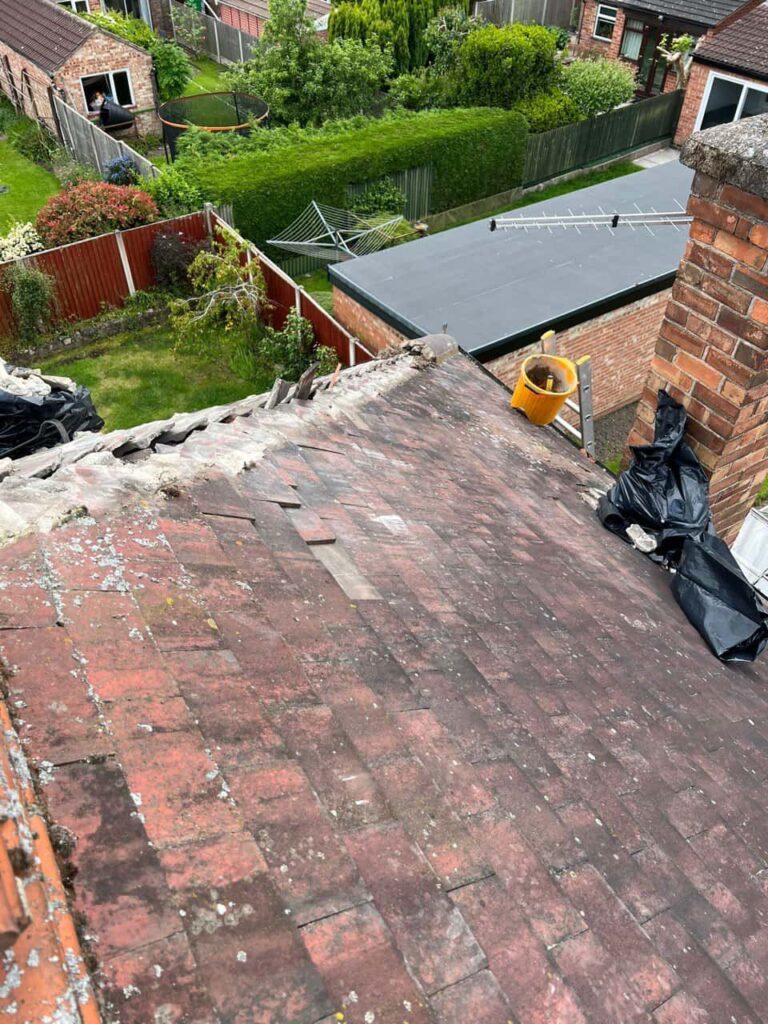A roof is often out of sight and out of mind—until something goes wrong. Yet sudden roof failures can lead to serious damage, disruption, and stress. At Sidcup Roofing Repairs, we believe that understanding the root causes helps homeowners in Sidcup and Greater London spot warning signs early, act decisively, and avoid costly emergency restorations.
In this article we explore the seven most frequent triggers behind roofs failing unexpectedly. We also suggest how professional roofers like us step in to prevent or remedy these issues effectively.
Why Sudden Roof Failures Happen
Most roofs don’t collapse overnight—they deteriorate over time. But certain factors accelerate the process or precipitate abrupt breakdowns. These causes typically fall into structural, material, weather, or maintenance categories. Below are seven common culprits.
1. Water Intrusion & Hidden Leaks
How it happens
Impermeable roofing relies on a watertight envelope. If that barrier is breached—via cracked tiles, deteriorated underlay, failed flashing, or compromised joints—water begins entering and undermining inner layers. Over time it weakens structural timbers, rusts metal components, and fosters rot or mould. In severe cases, sagging and collapse can follow. Structural engineers frequently list “deterioration from water intrusion” among prime causes of roof failure.
Signs to watch for
- Persistent damp patches or discolouration on ceilings
- Darkening or sponginess in roof timbers
- Dripping or condensation in loft spaces
- Moss or algae spreading across vulnerable zones
What we do
We inspect roof components with moisture-detecting tools, remove failed elements, reseal flashing, renew underlay where necessary, and restore the waterproof integrity—with minimal disruption to your home.
2. Poor Drainage and Water Ponding
How it happens
Roofs (especially flat or shallow-pitched) depend on safe drainage. Blocked gutters, misaligned fall, or clogged outlets cause water to stagnate. The weight and pressure of standing water (ponding) stress the roof deck, promote leakage, and accelerate material fatigue.
Signs to watch for
- Pools or gullies of standing water after rain
- Sagging or soft spots in flat roof decks
- Stains or damp patches following heavy rainfall
- Overflowing gutters or overflowing downpipes
What we do
We flush and clear drainage systems, re‑shape or regrade roof slopes if needed, and install additional outlets or scuppers to relieve pressure quickly. Our goal is to prevent any part of your roof from holding water longer than 48 hours.
3. Faulty or Deteriorating Flashing and Junctions
How it happens
A roof is full of penetrations: chimneys, skylights, vents, pipes, dormers. Flashing (lead, zinc, or comparable metals) seals these vulnerable junctions. Over time, flashing can corrode, crack, separate or fail to adapt to thermal movement. Once flashing fails, water bypasses the barrier and enters the structure.
Signs to watch for
- Rusting or discoloration of flashing
- Cracks, gaps or separation at flashing seams
- Leaks immediately around chimney or vent base
- Loose or missing leadwork
What we do
We replace or re-seal flashings using high‑grade metal, secure upstands properly, ensure correct overlaps, and integrate them fully with tiles, slates, or membrane. Good flashing is essential to protect vulnerable junctions.
4. Substandard Installation or Workmanship
How it happens
Even premium materials cannot compensate for poor workmanship. Mistakes such as incorrect fastener spacing, improperly aligned tiles, insufficient lapping, weak underlay, or shortcuts in sealing can cause early roof failure.
Signs to watch for
- Uneven roof slopes or tiles
- Loose or shifting tiles
- Leaks in new or “recently repaired” roofs
- Visible gaps or misaligned ridges
What we do
At Sidcup Roofing Repairs we pride ourselves on robust craftsmanship. We adhere to best practices, use quality fixings, and follow manufacturer guidelines to ensure that everything is installed to last. Our workmanship stands up to inspection and weather.
5. Ageing Materials and Weathering
How it happens
All roofing materials degrade under sun, rain, frost, wind, temperature shifts, and ultraviolet exposure. Over time, slates crack, shingles lose granules, membranes blister, or support timbers shrink or split. This erosion weakens their capacity to repel water and maintain structure.
Signs to watch for
- Cracked, curling or flaking tiles/slates
- Granule loss or bald patches on shingles
- Blistering, bubbling or splits in membranes
- General thinning or brittleness
What we do
We monitor the condition of materials over time. For roofs approaching the end of their service life, we advise phased repairs or renewal before failure occurs. Where appropriate, we apply protective coatings or reinforcement to extend life.
6. Insufficient Ventilation and Condensation
How it happens
Inadequate airflow in the loft or roof space causes moist warm air from within the home to condense on cooler surfaces. Over time, that moisture accelerates timber decay, encourages mould, and affects structural integrity. Poor ventilation is a known source of internal roof damage.
Signs to watch for
- Black mould or fungal growth in loft or roof timbers
- Wet or dripping insulation
- Rotting or spongy roof timbers
- Flaking paint or peeling plaster below roof
What we do
We install or upgrade ventilation systems—ridge vents, soffit vents, air bricks—ensuring a continuous airflow that balances underlay vapour control. Proper ventilation protects both your roof and your indoor environment.
7. Impact Damage, Overloading & Structural Alteration
How it happens
Roofs may suffer sudden damage from external impact (fallen tree limbs, debris in storms), or be overloaded by extra weight (e.g. heavy plant, snow drift). Further, ill-considered structural modifications—cutting through rafters or overloading with added insulation or decking—can stress the roof beyond its design capacity.
Signs to watch for
- Cracked or displaced tiles after a storm
- Localised collapse or sagging
- Evidence of recent work that cut or altered structural members
- Heavy or new loads on roof surfaces
What we do
We inspect for impact damage and reinforce or replace affected members. If a roof’s load capacity has been compromised, we design structural strengthening and ensure all roof elements function properly under current conditions.
Why Act Quickly—and Why Choose Sidcup Roofing Repairs
Sudden roof failures may initially appear confined, but damage often ripples inward—jeopardising plasterwork, insulation, structure, and internal spaces. Prompt intervention limits harm and cost.
At Sidcup Roofing Repairs, every roof assessment is meticulous. We use visual inspection, moisture-detection tools, and structural evaluation to pinpoint defects before they worsen. Our repair and restoration work is carried out by experienced professionals using quality materials and accepted best practices. Because we serve the Sidcup and Greater London area, we are familiar with local roofing conditions, weather exposures, and building styles.
If any of the warning signs listed above sound familiar, or if your roof has suffered damage in a recent storm, contact Sidcup Roofing Repairs today. Let us assess your roof’s integrity and take corrective action before a small issue becomes a failure.
Call us on: 0208 059 8598
Click here to find out more about Sidcup Roofing Repairs
Click here to complete our contact form and see how we can help with your roofing repairs.

